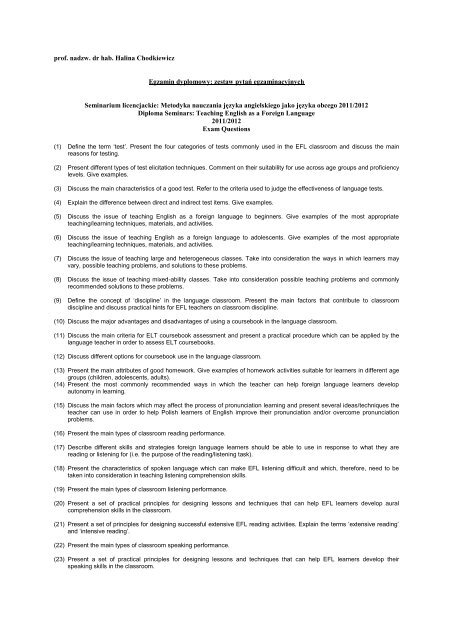prof. nadzw. dr hab. Halina Chodkiewicz Egzamin dyplomowy ...
prof. nadzw. dr hab. Halina Chodkiewicz Egzamin dyplomowy ...
prof. nadzw. dr hab. Halina Chodkiewicz Egzamin dyplomowy ...
- No tags were found...
Create successful ePaper yourself
Turn your PDF publications into a flip-book with our unique Google optimized e-Paper software.
<strong>prof</strong>. <strong>nadzw</strong>. <strong>dr</strong> <strong>hab</strong>. <strong>Halina</strong> <strong>Chodkiewicz</strong><strong>Egzamin</strong> <strong>dyplomowy</strong>: zestaw pytań egzaminacyjnychSeminarium licencjackie: Metodyka nauczania języka angielskiego jako języka obcego 2011/2012Diploma Seminars: Teaching English as a Foreign Language2011/2012Exam Questions(1) Define the term ‘test’. Present the four categories of tests commonly used in the EFL classroom and discuss the mainreasons for testing.(2) Present different types of test elicitation techniques. Comment on their suitability for use across age groups and <strong>prof</strong>iciencylevels. Give examples.(3) Discuss the main characteristics of a good test. Refer to the criteria used to judge the effectiveness of language tests.(4) Explain the difference between direct and indirect test items. Give examples.(5) Discuss the issue of teaching English as a foreign language to beginners. Give examples of the most appropriateteaching/learning techniques, materials, and activities.(6) Discuss the issue of teaching English as a foreign language to adolescents. Give examples of the most appropriateteaching/learning techniques, materials, and activities.(7) Discuss the issue of teaching large and heterogeneous classes. Take into consideration the ways in which learners mayvary, possible teaching problems, and solutions to these problems.(8) Discuss the issue of teaching mixed-ability classes. Take into consideration possible teaching problems and commonlyrecommended solutions to these problems.(9) Define the concept of ‘discipline’ in the language classroom. Present the main factors that contribute to classroomdiscipline and discuss practical hints for EFL teachers on classroom discipline.(10) Discuss the major advantages and disadvantages of using a coursebook in the language classroom.(11) Discuss the main criteria for ELT coursebook assessment and present a practical procedure which can be applied by thelanguage teacher in order to assess ELT coursebooks.(12) Discuss different options for coursebook use in the language classroom.(13) Present the main attributes of good homework. Give examples of homework activities suitable for learners in different agegroups (chil<strong>dr</strong>en, adolescents, adults).(14) Present the most commonly recommended ways in which the teacher can help foreign language learners developautonomy in learning.(15) Discuss the main factors which may affect the process of pronunciation learning and present several ideas/techniques theteacher can use in order to help Polish learners of English improve their pronunciation and/or overcome pronunciationproblems.(16) Present the main types of classroom reading performance.(17) Describe different skills and strategies foreign language learners should be able to use in response to what they arereading or listening for (i.e. the purpose of the reading/listening task).(18) Present the characteristics of spoken language which can make EFL listening difficult and which, therefore, need to betaken into consideration in teaching listening comprehension skills.(19) Present the main types of classroom listening performance.(20) Present a set of practical principles for designing lessons and techniques that can help EFL learners develop auralcomprehension skills in the classroom.(21) Present a set of principles for designing successful extensive EFL reading activities. Explain the terms ‘extensive reading’and ‘intensive reading’.(22) Present the main types of classroom speaking performance.(23) Present a set of practical principles for designing lessons and techniques that can help EFL learners develop theirspeaking skills in the classroom.
(24) Discuss the differences between the product approach and the process approach to writing instruction in the EFLclassroom.(25) Present briefly controlled writing techniques and guided writing techniques which can be used in the EFL classroom inorder to help learners develop their writing skills.(26) Present a set of practical principles for designing lessons and techniques that can help EFL learners develop their writingskills.(27) Discuss the differences between the deductive method of teaching grammar and the inductive method. Discuss the mainadvantages and disadvantages of different approaches that teachers can take in offering grammatical instruction in theEFL classroom.(28) Discuss different ways/techniques of presenting the meaning of new vocabulary items in the EFL classroom.(29) Discuss the main advantages and disadvantages of using group work and pair work in the language classroom. Presentways in which the teacher can carry out successful group and pair work.(30) Present an effective procedure for organizing pair work and group work in the classroom.
















